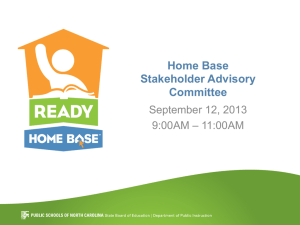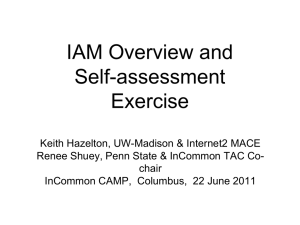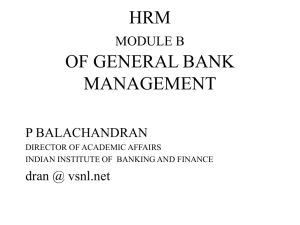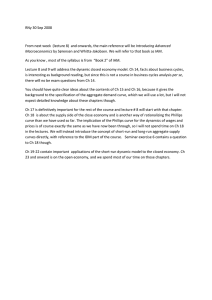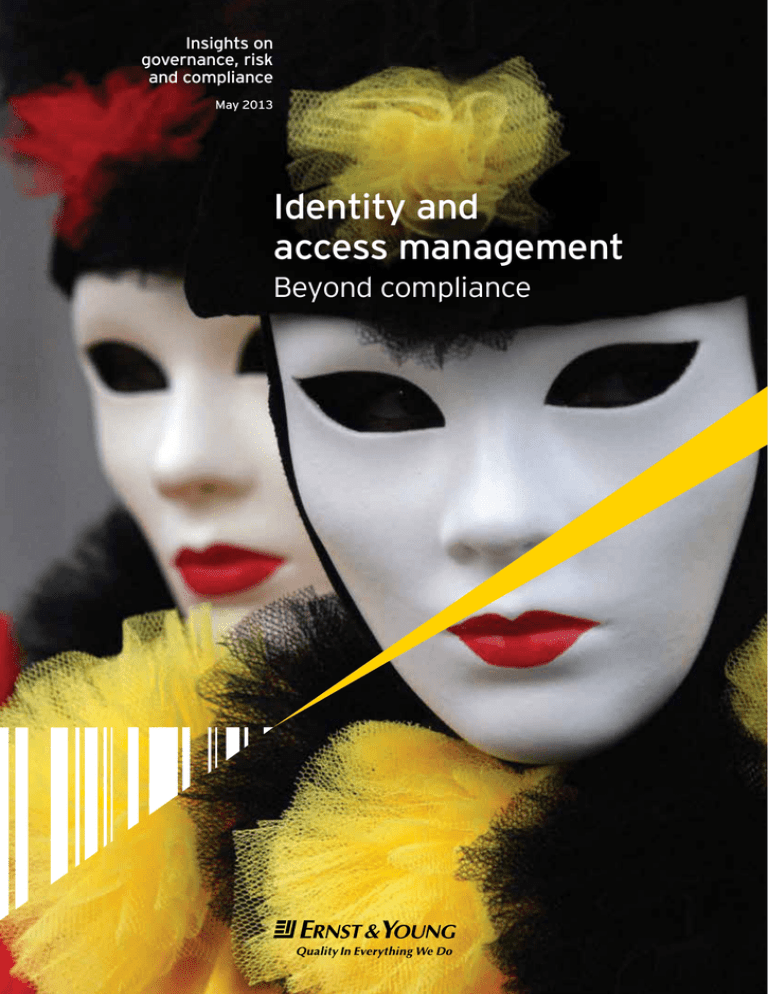
Insights on
governance, risk
and compliance
May 2013
Identity and
access management
Beyond compliance
Contents
Evolution of IAM — moving
beyond compliance.............................. 1
IAM life cycle phases............................ 2
IAM and IT trends................................ 4
Mobile computing........................................4
Cloud computing..........................................5
Data loss prevention....................................6
Social media................................................6
Capability maturity model.................... 8
Transforming IAM.............................. 10
Key considerations when
transforming IAM............................... 12
IAM tools........................................... 14
Getting started.................................. 16
Conclusion.........................................
18on governance, risk and compliance | May 2013
iii
Insights
Evolution of IAM —
moving beyond compliance
Identity and access management (IAM) is the discipline for managing access to enterprise
resources. It is a foundational element of any information security program and one of the
security areas that users interact with the most.
In the past, IAM was focused on establishing capabilities to support access management and access-related
compliance needs. The solutions were often focused on provisioning technology and were poorly adopted;
they also resulted in high costs and realized limited value. Organizations often struggled to meet compliance
demands during this period, and the solutions were deployed to manage very few applications and systems.
Centralized, standardized, automated identity management services designed to reduce risk, cost, improve
operational efficiency continued to be elusive.
Many organizations now understand, or meet, their compliance requirements. While compliance is still a key
driver in IAM initiatives, IAM is evolving into a risk-based program with capabilities focused on entitlement
management and enforcement of logical access controls. Organizations are starting to achieve benefits from
their IAM costs but are still challenged with managing time-intensive processes such as manual approval,
provisioning and access review. Identity administration functions continue to be delivered in organizational silos
resulting in users with excessive access, inefficient processes and higher cost of provisioning and de-provisioning.
As IAM continues to evolve, organizations will look to broader, enterprise-based solutions that are adaptable to
new usage trends such as mobile and cloud computing. IAM capabilities will continue to leverage technologies to
realize higher benefits versus the costs incurred. User demand will continue to drive the discipline to transform
from a compliance-based program into a true business enabler (e.g., IAM is a key component for rolling out B2E
and B2C applications that will drive operational efficiencies and improve the user experience) while helping to
reduce risks created by emerging technologies and threats. To help reach the goal of an enabler that reduces
risks, this IAM-focused paper explains life cycle phases, relevant IT trends, a capability maturity model, key
considerations for transformation, tools and how to get started.
IAM 1.0 — the past
IAM 2.0 — the present
IAM 3.0 — the future
•
•
•
•
•
•
•
•
• Enterprise-based deployment
• Capability-driven approach
• Business enablement driven
•
•
•
•
P
► roject-based deployment
Compliance-driven approach
Provisioning focused
Individual employee identity
management
High cost vs. benefits realized
Limited compliance value
Limited view of enterprise access
Poor application adoption
Early 2000s —
Well-publicized
control failures
•
•
•
•
•
Program-based deployment
Risk-driven approach
Entitlement management focused
All user identity management
(e.g., employees, contractors,
system accounts)
High compliance value
High compliance cost
Moderate benefits realized vs. cost
Central view of access
Increased application adoption
Circa 2005 —
Today —
Access control (SOX)
and manual access
review processes
implemented
Access review
fatigue; struggling
to incorporate new
technologies
Insights on governance, risk and compliance | May 2013
• High benefits realized vs. cost
• High business value beyond
compliance
• Central view of access
by technology
• Strong technology adoption
1
IAM life cycle
phases
The management of identity and access
permissions can be viewed as multiple stages.
The IAM life cycle diagram illustrates the stages that users
proceed through when joining a business workforce and
obtaining access to the tools and assets necessary to do their
job. The IAM life cycle also includes stages to ensure that
employees maintain appropriate access as they move within
the organization with access being revoked or changed when
they separate or change roles.
An IAM program requires a well-defined strategy and
governance model to guide all the life cycle phases.
User access request and approve
Definition objective:
• G
► aining access to the applications, systems and data
required to be productive.
Common challenges:
• Processes differ by location, business unit and resource.
• A
► pprovers have insufficient context of user access needs —
do users really need access to private or confidential data.
• U
► sers find it difficult to request required access.
Reconcile
Definition objective:
• Enforcing that access within the system, matching
approved access levels.
Common challenges:
• A
► ctual rights on systems exceed access levels that were
originally approved/provisioned.
• There is no single authoritative identity repository for
employees/non-employees.
Review and certify
Definition objective:
• Reviewing user access periodically to realign it with job
function or role.
Common challenges:
• Processes are manual and differ by location, business
unit and resource.
• Reviewers must complete multiple, redundant and
granular access reviews.
• Reviewers have insufficient context of user access needs.
Governance should align the IAM program with both business objectives and the risk landscape. When solutions are focused on
the business unit, they often fail to support the entire enterprise requirements and increase the cost of IAM. Typical pitfalls include
the difficulty of managing access consistently across the enterprise and the increased complexity (which also drives up the cost) of
incorporating new technologies into the existing IAM processes. Finally, it is essential to actively educate users about the policies
behind IAM to support governance objectives, thus allowing IAM to quickly adapt to new trends.
2
Insights on governance, risk and compliance | May 2013
IAM life cycle
Provision/de-provision
Definition objective:
• G
► ranting users appropriate entitlements and access in a
timely manner►.
• Revoking access in a timely manner when no longer
required due to termination or transfer.
Strategy and governance
User access request
and approve
Provision/
de-provision
Identity
Reconcile
Enforce
IT
resources
Enforce
A ccess
Review and
certify
Common challenges
• Time lines to grant/remove access are excessive.
• Inefficient and error-prone manual provisioning processes
are used.
• Access profile cloning occurs inappropriately.
• Ad hoc job role to access profile mappings exist.
• Inappropriate access may not be de-provisioned.
Report and
audit
Definition objective:
• Enforcing user access to applications and systems using
authentication and authorization.
• Enforcing compliance with access management policies
and requirements.
Common challenges:
• Applications do not support central access management
solutions (directories, web single sign-on)►.
• Access management policies do not exist►.
• Role/rule-based access is used inconsistently.►
• Segregation of duties (toxic combinations) is
not enforced
Report and audit
Definition objective:
• D
► efining business-relevant key performance indicators (KPIs) and metrics.
• A
► uditing user access.
Common challenges
• KPIs/metrics do not exist or do not align with business-driven success criteria
(e.g., reduce risk by removing terminated user access on the day of termination).
• Audits are labor intensive.
Insights on governance, risk and compliance | May 2013
3
IAM and IT trends
Consumer demand is driving
the corporate IT environment.
Business demands for IT are
changing rapidly — so too are
the demands on IAM — resulting
in the requirement to adopt
emerging technologies (e.g.,
mobile and cloud computing,
data loss prevention, and social
media) earlier and more quickly.
IAM is a key element in enabling the use of these technologies and achieving business
objectives, further emphasizing the need for IAM to grow beyond a mere compliance
solution into a valued business tool.
Mobile computing
As today’s workforce becomes more mobile, many organizations are adopting a bring
your own device (BYOD) approach to provide remote access to email, sensitive or
privacy-related data, and business applications. Consumer demand for mobile computing
is also driving organizations to develop mobile applications to be used by customers to
access their products. IAM is a strong enabler of mobile computing (both for business to
employee and business to consumer) and serves as a foundational component in mobile
computing security.
Here are a few ways IAM can help an organization implement a more secure mobile
computing program:
• Security safeguards normally in place for external connections to a network may be
disabled or implemented at a reduced level because the business may not have control
over management of these devices (especially in a BYOD model). As a result, it is
critical that authentication mechanisms are implemented to confirm that the user of
the device is authorized to access sensitive resources.
• Mobile devices allow company personnel to access critical applications (including
privacy-related data) any time and from anywhere. If a device is lost or stolen, the
detection of compromised devices should not be left solely to user reporting. Device
and user authentication attempts can help to detect a compromised device and reduce
potential incidents of fraud.
• Access controls should be designed with usability in mind; without this, users may
circumvent overly restrictive and inconvenient controls, resulting in potential data
loss incidents. A common example is someone forwarding personally identifiable or
confidential information unencrypted to a personal email account in order to access it
outside of the office.
The proliferation of mobile devices (e.g., smartphones, tablets) and a strong consumer
demand has driven organizations to adopt a BYOD model. This new reality has blurred
the boundaries between home and office by providing constant access to email, sensitive
data and even business applications enabling financial transactions.
4
Insights on governance, risk and compliance | May 2013
To allow these devices to access the organizations’ resources
quickly and efficiently, mobile devices are set up to rely on
identification mechanisms that verify and/or validate the user;
security safeguards normally in place for external connections to
a network may be disabled or implemented at a reduced level due
to these mechanisms. As a result, it is critical that even stronger
authentication mechanisms are implemented to confirm the
user of the device is genuine and to safely allow users access to
business critical applications anytime, anywhere.
Consumer demand for mobile computing is also driving
organizations to develop mobile applications that customers
can use to access their products. Mobile applications may allow
consumers to access or transmit sensitive information
(e.g., bank account information during an online transaction,
private personal information submitted through a health insurance
application). However, poor controls over authentication to the
application, access to the data stored on the device by the application
and external connections initiated by the application could increase
the likelihood of a data compromise. IAM should be incorporated
into application design, pre-implementation testing and periodic
vulnerability scans/tests performed after implementation.
Cloud computing
The emergence of, and demand for, cloud computing services has
complicated the IAM landscape as control over access to sensitive
data is difficult to maintain in such an environment. This reality
has forced many organizations to operate IAM capabilities internally
and to invest in integration with similar capabilities provided by their
cloud service provider. The adoption of cloud computing platforms
have resulted in reduced reliance on network access controls and
increased reliance on logical access controls offered by IAM services.
Several distinct scenarios have emerged with the evolution of
cloud computing and IAM — there is a need to securely access
applications hosted on the cloud, and there is a need to manage
identities in cloud-based applications, including protecting
personally identifiable information (PII). Federation, role-based
access (RBAC) and cloud application identity management
solutions have emerged to address these requirements.
The concept of identity as a service (IDaaS) is also an emerging
solution to this challenge and has made it possible to accelerate
the realization of benefits from IAM deployments. IDaaS aims
to support federated authentication, authorization and
provisioning. As an alternative to on-premise IAM solutions,
IDaaS allows organizations to avoid the expense of extending
their own IAM capabilities to their cloud service provider but
to still support secure interaction with a cloud computing
environment. When using IDaaS, instead of a traditional onpremise IAM system, these capabilities are provided by a thirdparty-hosted service provider.
However, unless cloud computing services form an organization’s
sole IT infrastructure, the need for IAM capabilities to manage
access to internally hosted applications will persist. The truth of
this hybrid operating model is that IDaaS will need IAM agents
or appliances to operate within an organization’s remaining IT
infrastructure to completely outsource the function. Securing
these agents and their interfaces represents a new source of risk
for most organizations.
Regardless of the operating model used, cloud computing creates
new IAM risks that must be managed. Management of virtual
servers within the cloud requires elevated rights that when
compromised, may give attackers the ability to gain control of
the most valuable targets in the cloud. Such rights also give
attackers the ability to create sophisticated data intercept
capabilities that may be difficult for cloud providers to detect
in a timely manner. The risk of undetected data loss, tampering
and resultant fraud can be magnified by the use of cloud
computing unless equally sophisticated controls are in place.
As a result, the implementation of controls over cloud computing
services should account for traditional and emerging risks that
are unique to the cloud.
Insights on governance, risk and compliance | May 2013
5
IAM and IT trends
Data loss prevention
Social media
Given recent public incidents related to data loss, data protection
is top of mind for many organizations. The first line of defense in
protecting data is identity and access management. Data loss
prevention (DLP) is a complementary information security discipline
that can be enhanced when leveraged with IAM capabilities.
Companies look to leverage social media to interact with their
customers and increase brand awareness, however there are
some serious IAM risks tied to these technologies. Legal,
compliance, regulatory, operational and public relations issues
are at the top of the list of potential social media risks that can
ultimately cause loss of customers and erosion of market share
and revenue. For example, on most of the popular sites (Twitter,
Facebook and LinkedIn), users are able to create company profiles
and communicate on behalf of the organization through social
media channels. This can create marketplace confusion because
of multiple messages and different audiences, policies and
practices. There have been other instances where a company’s
reputation has been damaged when their public-facing social
media accounts had been compromised and used to distribute
fake updates that spread quickly.
IAM tools can provide identity context to DLP tools to provide
better monitoring capabilities. Properly controlling access to
data will reduce the likelihood of a data loss incident — fewer
users with access to data results in less opportunity for data to
be inadvertently or intentionally compromised by an internal or
external user. In addition, DLP and IAM tools can be integrated to
provide more comprehensive monitoring capabilities.
A leading practice is to use an IAM tool to provide identity
information to a DLP tool that continuously monitors sensitive
transactions (e.g., financial statements, internal memos) to
establish an identity correlation to the events monitored. The
DLP tool is then set up to monitor for data loss events related to
these complex, sensitive data elements. Any events detected are
also correlated against data access levels and historical access
behaviors recorded by the IAM tool to detect potential fraud.
These solutions could be leveraged to address insider risk and
emerging threat vectors, e.g., advanced persistent threats.
By utilizing identity analytics using identity (human resource)
entitlement and user activity data, we can deploy more effective
privileged-user monitoring solutions for forensic analysis.
Properly implemented IAM can enable an organization to handle
the fast pace of emerging IT trends — as highlighted here with mobile
computing, cloud computing and DLP — but to determine where
an IAM program stands, we need a frame of reference or a model.
You should provide IAM requirements to suppliers of the social
media tools and services that you use to protect your accounts
from being compromised; typical requirements include adding
a second factor of authentication, receiving notifications of
failed login attempts and receiving notifications of attempts to
authenticate from geographic regions known to be the source for
frequent attacks designed to gain control of social media accounts.
In addition to protecting company-owned social media accounts,
it is also important to educate employees on the importance
of using discretion with social media. Revealing too much
information publicly on social media can enable attackers to get
information to help them with social engineering or abusing selfservice password resets. Employees can also reveal confidential
information about what IAM controls are in place if they are not
careful about what they post.
Properly implemented IAM can help an organization to handle
the fast pace of emerging IT trends — as highlighted here with
mobile computing, cloud computing, DLP and social media —
but to determine where an IAM program stands, we need a frame
of reference or a model.
6
Insights on governance, risk and compliance | May 2013
IAM and cyber crime
Cyber crime, particularly the extent of economic and
reputational damage that it can cause and the role that some
nation states play in sponsoring corporate espionage, is a
contentious issue. Regardless of the position that a company
takes on the extent or viability of such threats, a strong IAM
program helps to mitigate the effectiveness of some of a cyber
criminal’s tools: privilege escalation, reconnaissance, remote
access, social engineering and data exfiltration.
The following techniques can help to counter these attack vectors:
• Privileged user review
• Password management
• Identity-enabled networking
• Authentication and access control
• Integration with data loss prevention (DLP) tools
Insights on governance, risk and compliance | May 2013
7
Capability
maturity model
The following section outlines
some of the maturity levels for
the IAM life cycle phases and
corresponding capabilities.
Maturity level
Identifying an organization’s current IAM capabilities using a formal capability maturity
model is the foundation for prioritizing investments to close compliance gaps (if needed)
and identifying process improvements to drive cost reduction and reduce risk. Defining
the desired state is fundamental to defining a strategy and road map for improvement
of IAM capabilities.
Characteristics of capability
Processes
Level of automation
When processes are
automated, administrators
will execute processes
consistently
IT is used in an integrated
way to automate procedures,
providing tools to improve
quality and effectiveness
Managed
Processes are monitored for
improvement opportunities
and improved periodically
Automation/tools are
used in a limited or
fragmented manner
Defined
Standardized and
documented
Repeatable
Similar procedures are
followed by people
performing similar tasks;
highly reliant on the
knowledge of the individual
Optimized
Initial
Oversight
Compliance with procedures
is measured and action is
taken where processes do
not meet expectations
SLAs
SLAs met or exceeded and
targets are periodically
reset to drive continuous
process improvement
SLAs established and
compliance is monitored/
measured
SLAs established, but may
not cover all administrators:
may not be met consistently
Processes are manual and
time intensive
Responsibility is left to
the individual to follow
the process
No SLAs established
Processes are informal and
not standardized: applied
on an ad hoc basis
It is important to note that many organizations will not reach the “optimized” stage in all,
or even some, of the areas of the maturity model. The level an organization should be at
in the maturity model is dependent on the overall goals and strategy of the organization.
8
Insights on governance, risk and compliance | May 2013
Case study — IAM in practice
Bank
Original state
Toxic access combinations existed, user provisioning processes
did not address all relevant applications, and manual review
processes proved ineffective and inefficient.
Challenges
Due to the number of business units impacted by the remediation
efforts, there was a lack of consensus on the approach in addition
to the risks of an ineffective access management environment.
Maturity-level transformation
Repeatable to managed
IAM solution
Short-term solution
Data analysis techniques were used to quickly identify segregation
of duties conflicts across 800,000 entitlements (effort prioritized
by application criticality).
Longer-term solution
The company implemented a standardized process for the
provisioning and de-provisioning of user entitlements at the
operating system, database and application levels.
Benefits
The company developed segregation of duties remediation plans
based on risk to address more than 6,000 accounts. Balance
between short- and long-term solutions allowed the company to
prioritize resources and funding.
Insights on governance, risk and compliance | May 2013
9
Life cycle phase
Transforming IAM
1
User access request
and approve
2
Provision/
de-provision
3
Enforce
4
Report and audit
5
Review and certify
6
Reconcile
7
Strategy and
governance
To keep pace with IT trends and changing business needs, and to
leverage the insights from the capability maturity model, the IAM
function needs to be transformed.
IAM can be a highly manual process and still be effective in meeting an organization’s
goals, however in these instances the cost of labor is high and will likely outweigh the
cost of technology. On the other side of the spectrum, a highly automated IAM program
will have a very low cost of labor but a very high cost to implement and maintain. The key
is finding the balance between the cost of labor and the cost of implementation and
maintenance while still meeting the organization’s overall business, security and IAM goals.
Strategy andmethods
governance
Transformation
User access request
and approve
1
Provision/
de-provision
Identity
6
Enforce
A ccess
5
Review and
certify
7
3
IT
resources
Reconcile
10
2
4
Report and
audit
Strategy and governance
Insights on governance, risk and compliance | May 2013
Steps to move to defined or managed maturity levels
Potential capabilities
• D
► eploy a centralized access request and approval process to increase adherence to SLAs
and compliance requirements
• I► ntegrate access profiles into the centralized process to enforce consistent requests and
to streamline the process
• Use “real-world” roles (i.e., business-centric roles) to define appropriate access profiles
to increase user’s and approver’s understanding of the access being requested, reduce
the risk of excessive access, and align access requested with real-world job functions
• Support user self-service access request functionality to decrease the time needed to fulfill requests
• Entitlement management
• Role mining
• Role definition
• Role certification
• Segregation of duty rules
• Authoritative identity source
• User request portal
• Job role matrix or application
access matrix
D
► eploy an automated provisioning solution to:
• Enforce consistent processes and segregation of duties
• Eliminate the need for basic access requests so users can obtain access needed to be productive faster
• Enable timely access creation and removal
• Adjust access upon termination or role change to reduce likelihood of retention of inappropriate access
• I► ntegrated identity and access
service portal
• Automated account provisioning
• Advanced provisioning services
• Automated access request and
approval workflow
• Role-driven or rule-driven access
assignment
•
•
•
•
•
•
•
•
•
•
Increase consistency of processes
Maintain sensitive identity and credential information centrally
Correlate use of shared and administrative access with specific users
Detect potentially inappropriate use of administrative access
Enforce the use of stronger passwords for administrative accounts
Develop external authorization capabilities to reduce the likelihood of compromised passwords
and reduce authentication overhead for users
Deploy application access matrices, and role- and rule-based access, to reduce the risk of
inappropriate access and to force the continuous alignment of access granted with real-world
job functions
Perform segregation of duties analysis to define toxic access combinations
Integrate toxic access prevention capabilities into request, approval and provisioning processes
Review privileged-user access logs for reasonability, and implement behavioral analysis tools to
identify outlier activities
• Password management
• Shared password management
• Privileged password
management
• Centralized authentication service
• Risk-based authentication
• Web access management
• Enterprise (single sign on (SSO)
• Entitlement management
• Federation
• Identity-enabled networking
• Privileged access management
• Administrative access monitoring
• Behavioral analytics
• Define KPIs/reports to compare performance against success criteria
• Implement reports to support audit evidence requests in current and future solutions
• Reduce level of effort to support audits and enable sustained compliance
• Identity audit
• C
► ontinuous control monitoring
• I► dentity analytics
• D
► eploy a centralized, automated access review process to eliminate redundancy
• Establish risk-driven review cycles to reduce the amount of access to be reviewed during
any given cycle
• Display roles in access review reports in lieu of granular access details to increase the reviewer’s
understanding and to reduce the likelihood of excessive access being retained
• A
► dvanced access certification
• Periodic access certification
• Job change access certification
• ►Configure automated provisioning solution to automatically adjust access if not approved
• Exceptions resolved by automated access adjustment should trigger a user-specific off-cycle
access review
• Access reconciliation
• Assess the current state using a capability maturity model
• Define business-focused and risk-driven future state capabilities
• Develop an IAM strategy and transformation road map to close gaps between current and
target states
• Align the leadership structure of the IAM program with the organization structure to
institutionalize adaptation of IAM processes to meet evolving business needs, new technologies
and regulatory requirements
• Periodically review IAM metric reports to confirm improvement as the road map is executed
Insights on governance, risk and compliance | May 2013
•
•
•
•
Asset inventory
Identity data analytics
Strategy and road map
IAM policy definition
• Policy and control framework
• Continuous control monitoring
• IAM service-level management
11
Key considerations
when transforming
IAM
Having considered coming
IT trends and evaluated your
capability, you decide the time
is right to transform your IAM
program. The success of an IAM
transformation depends on the
interaction of people, processes
and technology.
People
• U
► sing a risk-based and business-centric approach, consider the downstream impact
on organization structure as well as on key stakeholders including IT customers
(business and operations), human resources, internal audit and users, so that any IAM
enhancements can progress smoothly and with minimal disruption to the business.
• A
► void confusion and contention over priorities by appointing one executive-level
“program owner” who is empowered to make decisions as required, supported by
committed stakeholders and executive sponsors from across the organization. IAM
enhancement programs should also have a dedicated program management team
that operates using an integrated plan vetted by auditors and compliance managers.
• B
► e proactive in establishing ongoing support by designating an experienced operational
manager as the “service owner” after the enhancements have been completed.
• P
► lace experienced staff on the program execution team as it takes a long time to
become skilled in IAM methodologies, control implementation, process reengineering,
stakeholder alignment, and program and change management.
Process
• I► ntegrate process improvements into awareness campaigns designed to educate
users in order to increase adoption rates.
• D
► ocument access control processes and perform periodic testing to validate that
processes are being followed.
• I► nform key stakeholders early (and often) that business processes will have to change
to accommodate the improvement of IAM capabilities. Temper that message with
the fact that IAM can simplify processes by eliminating manual, error-prone access
management procedures, including access requests, approvals and reviews.
Technology
• The leading IAM products have similar capabilities and can generally meet most IAM
requirements; however, these products are likely to need configuration and even
customization to meet IAM requirements that are unique to your organization.
• A
► key activity often included in transformation programs is to redefine access profiles
in terms of roles so that they can be more easily understood (using business-friendly
definitions that avoid technical jargon). Activities intended to produce such role
definitions will often require the use of a sophisticated, configurable role mining
technology that will suggest potential access profiles.
• T
► he definition of a business-friendly name and description for these access profiles
will require a substantial amount of analysis by subject matter resources that
understand your business.
When integrating people, process and technology, organizations can be inundated by
technology options. The next section addresses some of the important features.
12
Insights on governance, risk and compliance | May 2013
Case study — IAM in practice
Healthcare organization
Original state
The majority of the access management functions were
being performed in application and business unit silos using
different processes.
Challenges
Service-level and compliance requirements were difficult to
meet, and the operational silos led to a lack of accountability,
ownership and resolution of issues.
Maturity-level transformation
Initial to defined
IAM solution
The company established an access transformation program
with relevant stakeholders, application owners, HR and IAM
representatives.
The company increased adoption of centralized automated
services, implemented standard processes and scaled the central
infrastructure to serve the access management needs of the
business community.
Benefits
The company demonstrated access control compliance, effectively
reduced access-related risks, increased efficiency and reduced
costs related to access management functions.
Insights on governance, risk and compliance | May 2013
13
IAM tools
As they evolve their IAM programs,
organizations seeking to achieve
higher levels of IAM maturity
commonly will use commercially
available products with the
features listed in this table.
Life cycle phase
Technology features
• Web-based self-service access requests
User access request
and approve
• Approval processes capable of supporting risk-based
approval paths, approver notifications, delegation,
segregation of duties rules, and escalations for failure
to approve within service-level agreements (SLAs)
• Preapproved, automated access requests for
“Day 1” access
• Role-based access profiles to drive complex access
provisioning downstream
• Authoritative identity source integration to detect
hire, transfer and termination triggers
Provision/
de-provision
• Configurable approval, provisioning and de-provisioning
workflow, including automated escalation
• Automated provisioning and de-provisioning of
access to target systems using standard protocols or
native application program interfaces (APIs)
• Role-based access profile support
• Policy-driven access control for web applications
• Centralized directory services used for
authentication and authorization
Enforce
• Web services-based authentication and authorization
capabilities, including SAML (Security Assertion
Mark-up Language) and XACML (eXtensible Access
Control Mark-up Language)
• Federated authentication and authorization services,
which may be web-based
14
Insights on governance, risk and compliance | May 2013
Life cycle phase
Technology features
Report and audit
• Identity analytics capable of identifying high-risk user access and behavior profiles, rule- and
exception-based access analysis and reporting, and continuous access monitoring and reporting
• Generation of IAM service management metric reports.
• Configurable processes that support periodic, on-demand and user life cycle event-triggered
access reviews — also referred to as attestations or certifications
Review and certify
• The capability to tag access with risk ratings to support more frequent periodic access
reviews for higher risk access
• De-provisioning event generation to trigger revocation of access, which has been deemed
inappropriate during access reviews
• Role- and rule-variance monitoring and reporting
Reconcile
• High-risk user analysis (i.e., outlier analysis, behavior profiling)
• Rules- and exception-based access analysis
• Role and rule variance monitoring
• Role management, including role and rule mining, role definition reviews, role ownership
dispositioning in response to user life cycle events, such as transfers and terminations
Strategy and
governance
• Governance, risk and compliance monitoring, including risk management and tracking,
risk reporting dashboards, risk remediation plan tracking, data content and system
configuration monitoring
• IAM service management dashboards supporting KPIs and metric reports generated via
reporting and auditing technology
With the opportunities presented by the array of tools that support the people and processes needed
to transform the maturity of an organization’s IAM life cycle stage, it is natural to ask, “how do we
get started?”
Insights on governance, risk and compliance | May 2013
15
Getting started
When determining how to
transform your IAM program, the
diagram below illustrates the
common IAM areas classified by
business value and risk reduction.
The foundational areas serve as necessary building blocks for the other areas to be
successful and should be implemented before other initiatives are started. The size of the
circles defines the approximate level of effort of the area (i.e., bigger the circle, the higher
level of effort) — this will help you to prioritize your action plan.
Federation
Integrated identity and
access service portal
IAM service-level
management
Adaptive
authentication
IDaaS
Web access
management
Business
value
Enterprise SSO
Reduced
sign-on
Strategy and IAM policy
governance definition
Asset
inventory
Identity data
governance
Authentication
service
Authoritative
identity source
Identity
analytics
Multi-factor
authentication
Privileged access
management
Role management
Foundational
Risk reduction
16
Authorization
services
Automated
Process
Password provisioning
improvement management
Insights on governance, risk and compliance | May 2013
Role-based
access control
Key IAM capabilities
During the development of an IAM transformation plan, you should
confirm that the following recommended capabilities are included:
• J
► ob role or application access matrices using rule mining
tools: this serves as the logical access foundation needed
to embrace cloud-based and mobile applications in addition
to ensuring appropriateness of access a key regulatory
requirement, especially for data privacy.
• Automated workflow-based access request and approval
processes, using job role or application access matrices
and segregation of duties checking: this helps increase the
consistency and efficiency of your IAM procedures and reduce
the risk of inappropriate access.
• Entitlement warehouse solution: this accelerates the ability to
address security and access management needs across a high
volume of applications, host and database platforms within
large organizations: it results in streamlined provisioning/
access attestation and provides a centralized view of access
privileges across systems.
• A
► ccess proxy solutions, central authentication (application,
host and database layers): this improves the end user
experience and addresses key requirements around user
de-provisioning.
• Risk-based authentication solutions: this addresses exposures
related to compromise of basic authentication techniques,
enables secure access for sensitive transactions (e.g., access
to PII) and fulfills key regulatory requirements around multifactor authentication.
• Identity analytics and behavioral analysis services to
integrate with DLP and security information and event
management: this helps to enable behavior-based profiling,
identifies access outliers for risk-based verification and
effective reduction of insider risk. Context-aware identity
and access intelligence solutions are being used to identify
anomalous activities/exception-based access, perform account
analysis, and execute oversight and monitoring functions,
helping to protect data governed by privacy regulations.
• Data and access management process governance program,
which includes HR, application owners, information
security and IAM stakeholders: this helps to confirm that the
appropriate people (i.e., departments, roles) are supporting
and sponsoring the IAM program — vital to the success of
process and technology changes.►
• Federation solutions: this improves end user experience and
management of identities for cloud-based applications.►
• Consider emerging solutions that combine logical and
physical security: these solutions will address business risks
related to critical infrastructure protection.
• Design solution with future scalability requirements in
mind: these access transformation initiatives are impacted by
negative end user experience, including performance delays;
therefore, it is imperative to deploy solutions after considering
future adoption and scalability requirements.
Key capabilities can focus your starting point, but why strive to transform your IAM program to higher
maturity levels? How can it help drive business value?
Insights on governance, risk and compliance | May 2013
17
Conclusion
This paper examined the IAM life
cycle phases; explored relevant
IT trends; provided a capability
maturity model; considered the
people, processes and technology
of transforming IAM; enumerated
key features of tools; and showed
how to get started.
Effective identity and access management processes are integral to driving business value —
reducing risk, sustaining compliance, improving the end user experience and responding to
the changing IT landscape.
Your organization should first assess your existing IAM capabilities using the capability
maturity model and then develop a risk-based action plan.
Here are some guidelines for success:
• Develop a strategy that is aligned to the needs of the business and
considers people, processes and technology issues
• Don’t think of IAM as an IT-only initiative, especially when it addresses
business usage and regulatory requirements
• Be strategic, not tactical, when planning and designing a solution
• Because IAM is pervasive, be prepared for objections and concerns during
any transformation process
• Avoid the “Big Bang” approach; use a risk-based, phased implementation
approach to ease the integration and adoption of IAM changes
• Don’t rush to buy and implement a tool without first considering the
necessary business and process transformation requirements — tools
do not guarantee enhancements in maturity
• Creating an inventory of applications, systems and definition of businessfriendly access roles (profiles) are critical activities to ensure success of
an IAM program and will take longer than expected
• Don’t expect 100% assignment of access through roles; start with
enterprise-level roles first, then move to business-unit-level roles and
allow for exceptions
18
Insights on governance, risk and compliance | May 2013
Insights on governance, risk and compliance | May 2013
19
Want to learn more?
Insights on governance, risk and compliance is an ongoing series of thought leadership
reports focused on IT and other business risks and the many related challenges
and opportunities. These timely and topical publications are designed to help you
understand the issues and provide you with valuable insights about our perspective.
Please visit our Insights on governance, risk and compliance series at
www.ey.com/GRCinsights
Key considerations for your internal audit:
enhancing the risk assessment and
addressing emerging risks
Smart control: transforming controls to reduce cost,
enable growth and keep the busines safe
www.ey.com/SmartControl
www.ey.com/IA_considerations
20
Privacy trends 2013:
the uphill climb continues
Fighting to close the gap: Ernst & Young’s 2012
Global Information Security Survey
www.ey.com/PrivacyTrends
www.ey.com/giss2012
Ready for the challenge: integrated governance —
the key to effective business continuity management
Mobile device security: understanding
vulnerabilities and managing risks
www.ey.com/IntegratedGovernance
www.ey.com/MobileDeviceSecurity
Insights on governance, risk and compliance | May 2013
Insights on governance, risk and compliance | May 2013
21
Ernst & Young
Assurance | Tax | Transactions | Advisory
About Ernst & Young
Ernst & Young is a global leader in assurance,
tax, transaction and advisory services.
Worldwide, our 167,000 people are united by
our shared values and an unwavering
commitment to quality. We make a difference
by helping our people, our clients and our wider
communities achieve their potential.
Ernst & Young refers to the global organization
of member firms of Ernst & Young Global
Limited, each of which is a separate legal entity.
Ernst & Young Global Limited, a UK company
limited by guarantee, does not provide services
to clients. For more information about our
organization, please visit www.ey.com.
About Ernst & Young’s Advisory Services
The relationship between risk and performance
improvement is an increasingly complex and
central business challenge, with business
performance directly connected to the recognition
and effective management of risk. Whether your
focus is on business transformation or sustaining
achievement, having the right advisors on your side
can make all the difference. Our 25,000 advisory
professionals form one of the broadest global
advisory networks of any professional organization,
delivering seasoned multidisciplinary teams
that work with our clients to deliver a powerful
and superior client experience. We use proven,
integrated methodologies to help you achieve
your strategic priorities and make improvements
that are sustainable for the longer term. We
understand that to achieve your potential as an
organization you require services that respond to
your specific issues, so we bring our broad sector
experience and deep subject matter knowledge
to bear in a proactive and objective way. Above
all, we are committed to measuring the gains and
identifying where the strategy is delivering the
value your business needs. It’s how Ernst & Young
makes a difference.
© 2013 EYGM Limited.
All Rights Reserved.
EYG no. AU1638
In line with Ernst & Young’s commitment to minimize
its impact on the environment, this document has
been printed on paper with a high recycled content.
This publication contains information in summary form and is
therefore intended for general guidance only. It is not intended
to be a substitute for detailed research or the exercise of
professional judgment. Neither EYGM Limited nor any other
member of the global Ernst & Young organization can accept
any responsibility for loss occasioned to any person acting
or refraining from action as a result of any material in this
publication. On any specific matter, reference should be made
to the appropriate advisor.
ED None
How Ernst & Young makes a difference
At Ernst & Young, our services focus on our clients’ specific business needs and issues because
we recognize that these are unique to that business.
Effective risk management is critical to helping modern organizations achieve their goals, and
it offers the opportunity to accelerate performance while protecting against the uncertainties,
barriers and pitfalls inherent in any business. Integrating sound risk management principles and
practices throughout operational, financial and even cultural aspects of the organization can
provide a competitive advantage in the market and drive cost-effective risk processes internally.
Our 15,000 Risk professionals draw on extensive personal experience to give you fresh
perspectives and open, objective support — wherever you are in the world. We work with you to
develop an integrated, holistic approach to managing risk and can provide resources to address
specific risk issues. We understand that to achieve your potential, you need tailored services
as much as consistent methodologies. We work to give you the benefit of our broad sector
experience, our deep subject matter knowledge and the latest insights from our work worldwide.
It’s how Ernst & Young makes a difference.
For more information on how we can make a difference in your organization, contact your local
Ernst & Young professional or a member of our team listed below.
Contact details of our leaders
Global
Paul van Kessel
+31 88 40 71271
paul.van.kessel@nl.ey.com
Randall J. MIller
+1 312 879 3536
randall.miller@ey.com
Michael L. Herrinton
+1 703 747 0935
michael.herrinton@ey.com
Bernard R. Wedge
+1 404 817 5120
bernard.wedge@ey.com
Jonathan Blackmore
+44 20 7951 1616
jblackmore@uk.ey.com
Manuel Giralt Herrero
+34 91 572 7479
manuel.giraltherrero@es.ey.com
Jenny S. Chan
+86 21 2228 2602
jenny.s.chan@cn.ey.com
Rob Perry
+61 3 9288 8639
rob.perry@au.ey.com
Yoshihiro Azuma
+81 3 3503 1100
azuma-yshhr@shinnihon.or.jp
Haruyoshi Yokokawa
+81 3 3503 2846
yokokawa-hrysh@shinnihon.or.jp
Areas
Americas
EMEIA
Asia-Pacific
Japan

